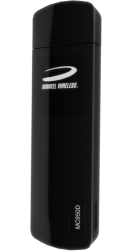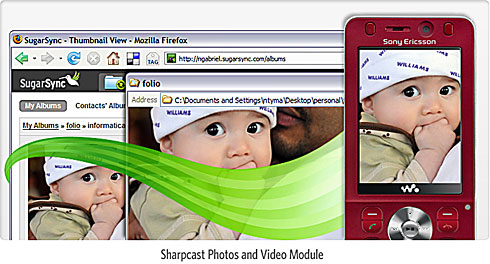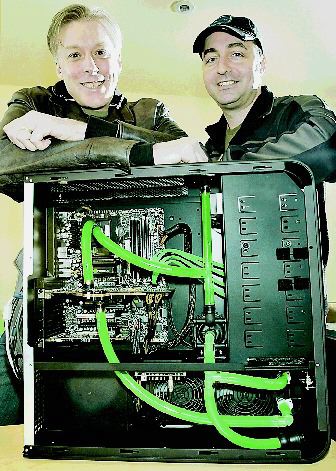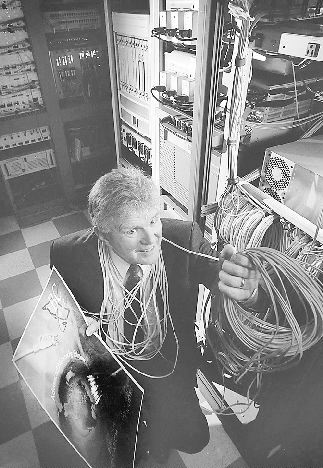Squeezebox Duet unleashes music on your computer
Edward C. Baig
USA Today

Logitech’s Squeezebox Duet consists of a receiver, left, and a remote control with charger. By Lance Shows, LogitechBy Lance Shows, Logitech
A lot of folks listen to music on — let’s face it — ho-hum-sounding computer speakers. About 95 million people are expected to pay for online music services this year, researcher IDC says. IDC adds that nearly two of three adults who use computers at home or the office access music on their PCs.
It doesn’t have to be that way. The new Logitech Squeezebox Duet network music system I’ve been testing liberates your music from the room in which the computer resides. That means you can wirelessly take Internet radio or songs trapped on a PC or Mac, and hear them pumped through the finest stereo in your house.
One big caveat: Squeezebox cannot play music that has copy protection — including many songs from Apple’s iTunes music store.
Squeezebox consists of just two components: a standard-size remote controller with a 2.4-inch, color LCD screen and a paperback-size black receiver that attaches to your stereo or powered speakers. They connect to your computer and each other via your home network.
You can do virtually everything from the palm of your hand, at least after the initial setup. The controller lets you browse and choose the music you want to play — from a gaggle of Internet radio stations, free and subscription services, such as Rhapsody, Pandora and Slacker, and your own music collection.
You can play podcasts and sound effects provided by the Squeezebox service (babbling brook, crackling fire, etc). And the remote can display album art, Flickr screensavers and RSS (Really Simple Syndication) news feeds.
With extra receivers, you can play the same song in multiple rooms or different songs in different rooms.
Squeezebox invites comparisons to the Sonos Digital Music system I raved about three years ago. Sonos set the standard for products of this type and is easier to set up and use. Still, Squeezebox is a welcome lower-cost alternative. It costs $400 for a single-room system vs. $1,000 for a two-room Sonos bundle. Extra Squeezebox receivers cost $150; extra controllers, cost $300. Here’s a closer look:
•Installation. Setup can be tricky for a non-techie. You have to be comfortable with your home networking settings. You can use Wi-Fi and/or ethernet. If you use Wi-Fi, you’ll have to enter its security key (if there is one) using the controller’s not-quite-iPod-caliber scroll wheel. Squeezebox uses the common 802.11g Wi-Fi technology that does not need a line of sight to the receiver. I had no problem controlling a basement receiver from an upper floor.
You’ll also have to connect the Squeezebox receiver to your home stereo or any powered speakers you want to listen through. You can do so via standard RCA-type analog cables, which are supplied, or digital optical and co-ax cables, which are not.
You can use Squeezebox without a computer, but you’ll need one for setup. You create a free online account at Logitech’s SqueezeNetwork. There, you enter account information for radio stations and music services you want to access on the remote, including Rhapsody and Pandora. You can also download software that lets you play tracks stored on a PC or Mac, as long as they don’t have copy protection.
I also created an online Music Locker account on MP3tunes.com. Uploading to the Music Locker meant I could leave my computer off and still hear my collection. Other restrictions may apply: For example, Rhapsody lets you connect to no more than three hardware devices per account.
Among the Internet radio options at your disposal are Live365, Radio IO and Shoutcast. If you know the URL or Web address of a favorite radio stream, you may also be able to play that over the network. Through another service called RadioTime, I was able to access local New York City stations.
•Playing music. The Squeezebox remote is generally easy to navigate. There’s the typical fast-forward, rewind and volume buttons, plus other controls to add songs or genres to a playlist. You can move up and down menus via the scroll wheel. The main menu is segregated by Music Library, Internet Radio and Music Services, and Settings, among other choices.
Still, it wasn’t intuitive enough. I was often tempted to start a song by pressing the center button inside the scroll wheel rather than a dedicated play button. You also have to choose a menu item to turn Squeezebox off. I’d prefer a physical button.
Annoyances: If the controller is in sleep mode, you’ll experience a brief delay before it reconnects to Wi-Fi.
Twice while using Pandora and Slacker, album art on the LCD didn’t refresh when a new song began. Rhapsody failed because of an unspecified “internal system error.”
The controller is an “open-source” Linux computer that developers can enhance in the future. They might take advantage of a limited-functioning headphone jack on top of the remote and an SD (Secure Digital) memory card slot in the battery compartment.
The battery is removable. Logitech says you can go 20-plus hours during basic use or five hours of constant scrolling, but I did have to recharge the unit a couple of times after not doing so overnight.
Despite imperfections, Squeezebox Duet is a fine product for people who want to free up digital music throughout the house.









